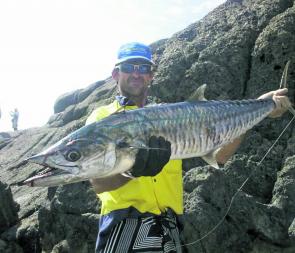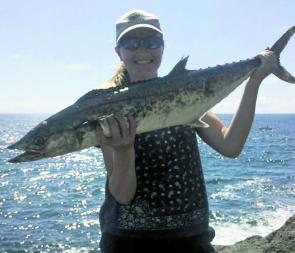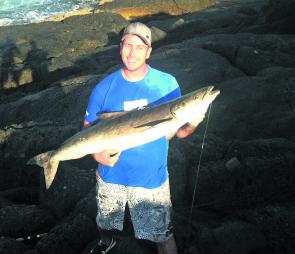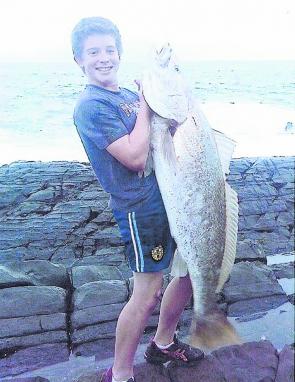Thousands of land based anglers head to the Macleay Valley each year to fish the rock ledges for a huge variety of species that seasonally visit our shores. There are many reasons rock fishing is so productive along this area of the mid north coast, however, the close proximity to the continental shelf and the fact that this region is visited by both southern and northern species of fish in huge numbers are 2 leading factors.
Mackerel, cobia, marlin, mulloway, and snapper are just some of the vast array of species that can be targeted in the area with a good chance of success. With plenty of headlands facing in all directions, it is usually possible to find a spot that is fishable and protected from the elements, no matter what conditions you are faced with.
Grassy Head is located to the north of South West Rocks and is the next headland up from where the Macleay River meets the sea. This small headland offers some safe fishing ledges with relatively easy access. Mulloway, bream and tailor are present for most of the year and can be targeted throughout the day, however, fishing an hour either side of sunset is the most productive time.
Due to the distance from Smoky Cape and the protected area it provides for Trial Bay, Grassy Head is affected by any big swells out of the south and north. This area is definitely a no-go area then during times of large swell. The reefs off Grassy are a haven for mackerel from Christmas through to May, and during this time land based anglers get their chance at a piece of the action too. Large stickbaits and metal spinners account for plenty of Spanish mackerel, longtail tuna and cobia from this area. Live baiting can be conducted here also, with bonito usually available from the washes. Yellowtail can be caught on occasions, however, it is worth being prepared if there are no bonito available by bringing in livies caught from elsewhere.
The northern wall at the southern end of the beach from Grassy Head fishes best when there is a deep gutter across the front and along the beach. You will find big mulloway, flathead, bream, tailor and Australian salmon laying in ambush on a runout tide. Live baiting mullet, pike and yellowtail are the gun options for capturing a big mulloway here. Large paddle tail soft plastics and hardbody diving lures have accounted for some big fish too.
The southern breakwall protrudes further out to sea than its northern partner. Due to the main channel of the Macleay running along the wall, it can be a tricky place to fish at times. The end fishes well on a runout tide and if there is a hole present it is possible to let your bait wash around in the back eddy that the river produces. Similar species to the northern wall will be found here. Firing floating bibbed divers out with the tide and slowly retrieving them over the holes that form alongside the bar channel is a popular approach for catching mulloway off the high rocks at the end of the wall.
Inside of the breakwall is easier to fish towards the top of the tide, as the run is slow and snags become less common. Bouncing soft plastics along the edge of where the rocks meet the sand is a good way to capture big flathead, school mulloway and bream. Blackfish are a common during the winter months.
These walls are also reasonably safe and can be fished in all but the worst conditions Mother Nature can dish up.
The gaol wall located at Laggers Point to the southern end of Trial Bay is easily accessed from the Trial Bay camping area. Flathead and whiting are found on the inside over the sand flats. Big bream hold up for the night in this corner during the winter months whilst seeking protection from larger predators. Unweighted fresh bait fished on light line is the best way to fool these wary fish.
The outside of the gaol wall through to Little Bay gives you direct access to the ocean. This stretch is riddled with reefs and bommies that can hold a lot of bait at times. Cobia, mackerel and bonito can be spun up from the ledges through the warmer months, while kingfish and tailor are available through most of the year. Berleying up the wash holes produces quality bream and drummer.
This area is reasonably protected from southerly winds, however, it has some low ledges that should be avoided at all costs during periods of any swell activity. There is a road that runs along a portion of this area, providing very good access as well as picnic tables and shelters if you want to bring the family along.
The area of rocks between Little Beach and Gap Beach is accessed from the Duck Ponds located at Arakoon. Mermaid Pools and Billygoat are 2 of the most popular spots in this region. Tailor, kingfish, mulloway, groper, and drummer are present along here, as well as visiting pelagics. Both headlands of Gap Beach are popular for mulloway fishing when deep holes form close to the headlands.
Inside of Green Island lies a series of ledges imaginatively known as The Ledges. Care must be taken here, as the places where you fish aren’t very high above sea level. This area can hold mulloway and kingfish most of the year, as well as bream and drummer in winter. Access is via the Jack Perkins track from Smoky Cape Lighthouse and is approximately 1200m from where you park your car along Little Smoky Beach.
Located off the northern side of Smoky Headland is a small island known as Gibraltar. Access is possible, however, it is strongly advisable to go with someone who knows the area and the access like the back of their hand. Depending on sand placement, the area will only be accessible at low tide, so be aware of this when fishing here. Big tailor, kingfish, Spanish mackerel and mulloway are the main targets off Gibraltar, with good numbers of bream, drummer and groper also found in the washes.
The areas under the front of the lighthouse can also be red hot. These are equally as dangerous as Gibraltar, with high cliffs sloping directly to the water underlying most of the track out there. Extreme caution should once again be taken in this area.
On the south side of Smoky Headland is the Cow Hole. This area is accessed from the north end of Smoky Beach. Mulloway and tailor are the main targets in the gutters and washes.
Perhaps 1 of the most famous headlands in the Macleay and possibly even NSW is Hat Head. The Hat is the closest landmass to the continental shelf on the east coast. The headland juts out to the north east, causing the East Australian Current to take a right hand turn that creates a back eddy up the beach.
This headland is a hive of activity all year round and has very good access. The north side provides the ultimate protection from a southerly wind. There are plenty of safe spots from the creek to the point, but the action really starts heating up from Bird Rock, located on the outside of Little Beach, to the point. Mulloway, blackfish, bream and salmon are common here through winter, but it is the seasonal run of pelagics that Hat Head is most famous for. Both longtail and yellowfin tuna, marlin, Spanish mackerel and cobia are taken each year from this famous ledge, as well as bigeye trevally and even the odd mahimahi and wahoo.
A life ring is located at Hat Head Point. Whilst these ledges are relatively safe, around the corner are some more sinister spots. The affectionately named Death Hole is a rope accessed area where extreme caution should be taken. Wards Hole is located further south, and once again extreme caution is required on these high ledges.
The Island is located on the south eastern side of the Hat. This area is accessed via a track down a steep hill and across a gutter that, depending on conditions, can be crossed at low tide. This spot and the area to the south on the mainland are very popular for cobia, Spanish mackerel, tuna and kingfish. Mulloway and tailor are located all the way from here to Connors Beach. The area from Hat Head Point to Connors Headland is very exposed to the south. Although not overly common, snapper can be taken from these headlands, usually after large seas.
Hungry Headland is as productive as Hat Head at times. The north side towards Third Beach is mulloway angler’s heaven, with a whole series of gutters and cracks that just about all hold mulloway depending on their depth and sand placement.
To the south side is a series of ledges that make live baiting pelagics like tuna, cobia and marlin possible, however, once again it is advisable to bring livies in with you. The little mulloway bite is located in closer towards the beach and when there is a gutter formed the area fishes well for bream, tailor and schoolies.
Rock fishing can be an extremely dangerous sport. Any area can become deadly very quickly if conditions change, so always keep your wits about you and watch the areas you plan to fish first. Do not fish alone, wear proper footwear, and make sure someone knows where you are. Always remember that no fish is worth dying for!
Reads: 17966
Sean Watson a prized Spanish mackerel taken from Hat Head Point.

Spotted mackerel can be taken from the stones occasionally.

Jumbo with a nice cobia taken from Hungry Headland.

Another solid Macleay mulloway taken from the stones.




